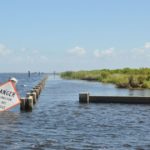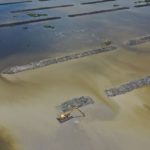If your project adversely impacts wetlands, the U.S. Army Corps of Engineers (USACE) will require you to compensate for the environmental destruction. This can be done in 1 of 3 ways; 1) permittee responsible mitigation, which is the act of creating wetlands yourself, 2) pay to the State of Louisiana’s in-lieu fund to finance a larger scale mitigation project, or 3) purchase wetland mitigation credits from a mitigation bank.
Under Section 404 of the Clean Water Act (CWA), wetlands may be legally destroyed. However, this destruction must be compensated for through the restoration, creation, or enhancement of other wetlands. The end goal is to ensure that there is no net loss of wetlands, natural habitats, and streams.
The number of mitigation credits that must be purchased will depend on the size, location, and potential impact of the development project. The value of the natural resources replaced by these banks is quantified in “credits” and sold to developers to offset their impacts.
Throughout this article, we’re going to discuss mitigation banks and wetland mitigation credits in further detail.
What Are Wetland Mitigation Banks?
Wetland mitigation banks are wetlands that have been restored, enhanced, or created. Their main purpose is to provide credits that offset adverse impacts on existing wetlands. Wetland mitigation banks can be located in areas that have previously supported wetlands or currently have degraded wetlands.
A mitigation bank is created by the bank owner under a formal agreement with the regulatory agency. This formal agreement is also known as the banking instrument.
The site is the physical area that will be created, enhanced, or restored. The banking instrument also establishes liability, performance standards, management requirements, and monitoring requirements to compensate for the loss of wetlands or streams.
The USACE and the Environmental Protection Agency (EPA) regulate and approve wetland mitigation banks, stream mitigation banks, and species conservation banks. These banks are set aside permanently to protect natural resources and the natural environment.
When a mitigation bank is formed, a team of biologists and consultants will work together to establish the right metrics and valuations to meet regulatory requirements.
The Interagency Review Team (IRT) oversees the bank to ensure that it’s operating as intended. Mitigation banks are an effective way to mitigate environmental impacts. The bank allows project proponents to use credits from these banks to offset their costs.
Since mitigation banks are set up on a large scale and ahead of time, mitigation bank credits can be readily available and can help the project proponents reduce the time required to complete permits for major projects.
A mitigation banker may build a mitigation bank on an active farm or a neglected piece of commercial property that’s been damaged by development.
The regulatory agencies will review and approve the mitigation banker’s plans—including the number of mitigation credits they can earn. Anyone planning commercial development can buy mitigation credits from an approved bank.
What is the Difference Between Wetland & Stream Mitigation Banks?
Wetland mitigation banks are created, restored, or enhanced wetlands. On the other hand, stream mitigation banks are created, restored, or enhanced streams.
Their primary purpose is to offset the loss of streams to development. Credits can be sold to commercial developers who are trying to offset mitigation debits.
Both wetland and stream mitigation banks are regulated and approved by the US Army Corps of Engineers (USACE) and the Environmental Protection Agency (EPA).
What are Conservation Banks?
Conservation banks are areas of land that are protected, to preserve threatened and endangered species and their habitats. Conservation banks help protect these species and their habitats by establishing offset credits in exchange for the preservation of land.
Landowners create these banks by entering into conservation easements with agencies like the US Fish and Wildlife Service (USFWS) and National Marine Fisheries Service (NMFS).
Conservation banks sell these credits to project developers who want to mitigate their impact on wildlife habitats. Aside from the USFWS and NMFS, other agencies may participate in the regulatory and approval process.
Landowners who choose to participate in conservation banks can sell the credits they’ve earned for the conservation of their property to commercial developers. In some states, conservation credits can be worth hundreds of thousands of dollars.
How Does Mitigation Banking Work?
Mitigation banking is a new type of credit system that allows banks and other financial institutions to purchase and sell credits in exchange for a percentage of the risk associated with certain transactions.
It is an excellent way to mitigate risks associated with development projects while conserving the environment. Other benefits include increased efficiency and reduced costs associated with regulatory compliance.
The term mitigation banking refers to an investment vehicle that allows investors to use a portion of their funds to restore ecologically damaged sites. These investments can be made through the outright purchase of land, development of a management plan with a conservation easement, or a design-construct restoration plan.
These investments can also be made on state or agency-owned lands. As with all investment vehicles, mitigation banking requires approval by a regulatory authority.
The mitigation banker is an entity or individual that does the work associated with establishing and operating a mitigation bank. The banker then sells mitigation credits to companies and individuals seeking to comply with environmental regulations.
Mitigation credits are equivalent to ecological assets and extractable natural resources. A mitigation banker will oversee the project and track its progress over time. The US Army Corps of Engineers (USACE) administers the program and mandates mitigation banks.
Mitigation bankers purchase sites for regeneration and work with the applicable regulatory agencies to obtain approval for their plans. The banks are screened by environmentalists and scientists who assess the viability of the area and outline their requirements.
Here are the four main components of a mitigation bank. This will help you to understand how a mitigation bank operates:
1. The bank site
The bank site is the area that has been set aside for environmental regeneration or preservation.
2. The bank instrument
Mitigation banks are created by mitigation bankers under a formal agreement with a regulatory agency. The bank instrument defines the site and outlines the performance standards, as well as the management and monitoring requirements, that the banker must adhere to.
3. The Interagency Review Team (IRT)
The IRT approves, reviews, and oversees the mitigation bank. This group is composed of representatives from federal, state, and local agencies. They meet regularly to discuss mitigation banking and create standards for various projects. The IRT’s main goal is to maximize the use of mitigation bank credits and restore ecosystem health.
4. The service area – Hydrologic Unit Code (HUC)
This is the actual geographic area within which the permitted environmental impacts can be compensated for at a mitigation bank. The service area can range from a single site to an entire region or state.
The USACE uses the term Hydrologic Unit Code (HUC) to delineate service areas. The term “HUC” is also routinely used to refer to the service area.
What are the Benefits of Mitigation Banking?
Mitigation banking allows commercial developers to purchase credits from mitigation banks in order to offset the environmental impact of their projects. The main benefits of mitigation banking include; the protection and conservation of the environment, the efficient restoration of ecological sites, and the transference of liability from the developer to the banker.
1. Protects and conserves the environment
Mitigation bankers help protect the natural environment and offset the negative effects of development projects by creating mitigation credits within the same ecosystem. Mitigation projects also offer additional benefits. The Lake Boudreaux Living Mitigation Project, for example, created barriers to the north of Lake Boudreaux in Terrebonne Parish, Louisiana.
These barriers safeguard the community from storm surge impacts and create safe zones where wildlife can flourish.
2. More efficient ecological restoration
Mitigation banks facilitate the restoration of large, consolidated pieces of land rather than numerous small sites. This makes ecological restoration a more efficient and cost-effective process.
3. Eliminates uncertainty regarding the outcome of projects
Mitigation banking eliminates the uncertainty regarding the outcome of restoration projects. Since bank credits are awarded only when mitigation is successful, public agencies have the confidence to use them for capital improvement projects.
4. Transfers liability from the developer to the banker
Mitigation banking transfers the liability of ecological damage from the developer (also known as the permittee) to the banker. Once the permittee has purchased the required credits as mandated by the regulators, it becomes the responsibility of the mitigation banker to develop, maintain, and manage the bank site over the long term.
5. Helps developers avoid costly and time-consuming permits
Purchasing wetland mitigation credits can help developers avoid expensive, time-consuming, and invasive permits and regulations. Buying wetland mitigation bank credits can reduce the permitting time by more than 50%.
What are the Main Challenges of Mitigation Banking?
The main challenges facing mitigation banks include; the difficulty of assessing ecological damage in monetary terms, the difficulty of assigning credits to mitigation banks, and the challenge of recreating destroyed wetlands in bank sites.
While regulatory agencies utilize a number of environmental assessment techniques, it isn’t always easy to accurately translate ecological damage into their monetary equivalents. Nevertheless, accurate estimates need to be made since the offset credits offered to mitigation banks need to be fairly priced.
While the existing assessment techniques are useful, they rarely capture the full impact of mitigation projects. As a result, regulatory agencies tend to veer on the side of caution when they award credits.
Another major challenge facing mitigation banks is the proper allocation of credits to the banks. Regulatory agencies must first measure the regional significance of ecological features, as well as the science and engineering used by mitigation banks to achieve their goals. These, and other factors, make the allocation of credits a complicated and challenging process.
Just as importantly, it isn’t realistic to assume that wetlands and other habitats that took centuries to evolve can easily be replicated in just a few years. According to some audits, some artificially developed wetlands lacked the biodiversity of the ecosystems they were trying to replicate.
Is Wetland Mitigation Banking Profitable?
Wetland mitigation banking can be profitable for both the mitigation bank and its investors (both private and institutional). Mitigation banks generate wetland credits which can be sold at a profit to commercial developers who need them to offset the environmental impact of their projects.
Wetland mitigation banking has grown in popularity since the Environmental Protection Agency (EPA) issued federal guidance on the practice in 1995. This guidance laid the legal and regulatory framework for mitigation banking in the United States. It also gave the mitigation banking industry the official backing it needed to grow its business in the country.
Today, mitigation banking is utilized in different conservation initiatives, including wetland conservation and endangered species conservation. The mitigation banking industry is also expected to grow as a result of increasing government concern about the wetlands.
These, and other factors, make wetland mitigation investments a viable option for private and institutional investors.
Should You Purchase Wetland Mitigation Credits?
If you’re planning a major development project, there are many reasons why you should purchase wetland mitigation credits. Aside from the environmental benefits of preserving our waterways and restoring our aquatic life, these credits can help you reduce your development costs.
The main reason for purchasing wetland mitigation credits is that you’ll be free from any liability you might incur if you fail to mitigate your development site. The Corps of Engineers has approved mitigation banks, and these institutions provide developers with a secure and legal means to offset the costs of their projects.
Mitigation banks also allow developers to purchase credits for wetlands before they start building. Since these mitigation bank wetlands were created before being sold, they’re already in place before any environmental damage resulting from development occurs. This way, developers can reduce their impact while maintaining the value of their properties.
Mitigation bank credits can be used to offset the impacts of development on freshwater wetlands or riparian zones. Purchasing wetland mitigation bank credits can reduce the permitting time by more than 50%.
The process of buying credits is simple and fast. Banks or in-lieu fee programs reduce the risk to the permittee. While banks may increase the cost of your project, the time savings make them a valuable asset to your project.





